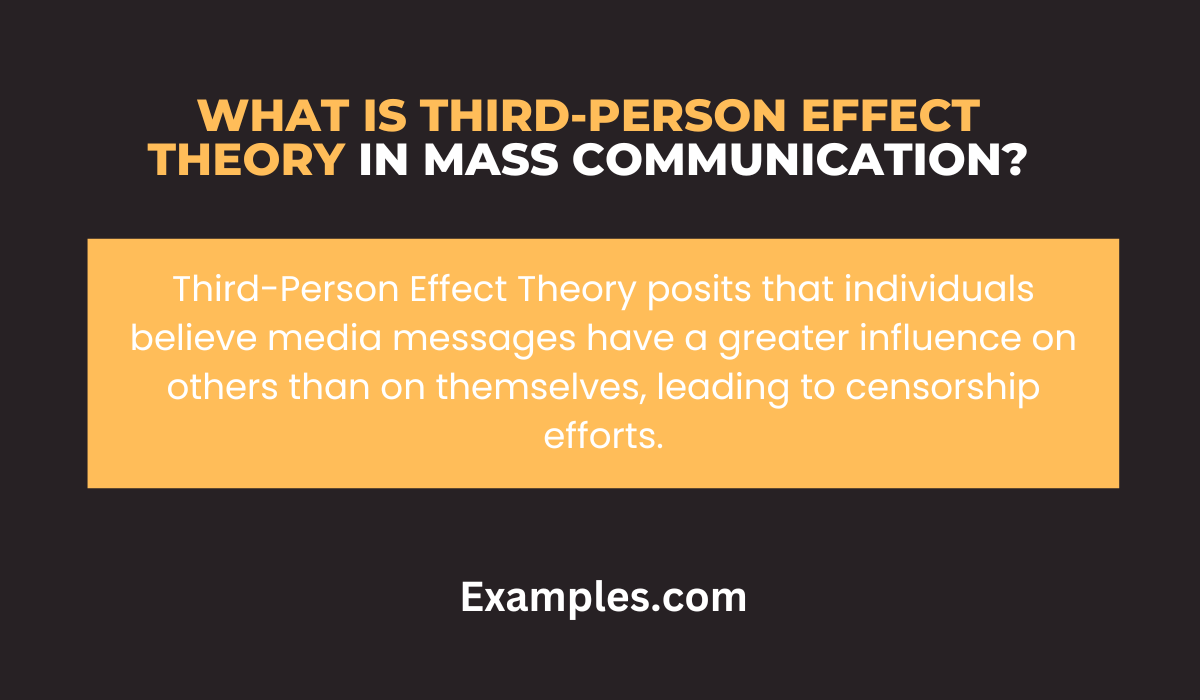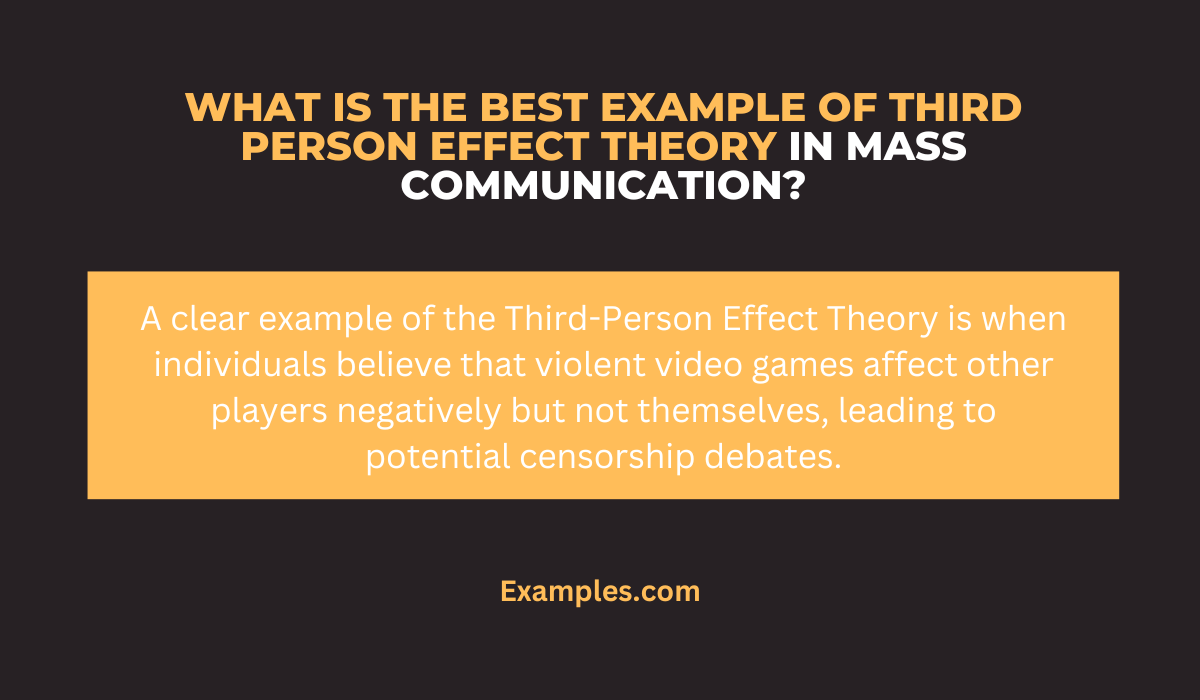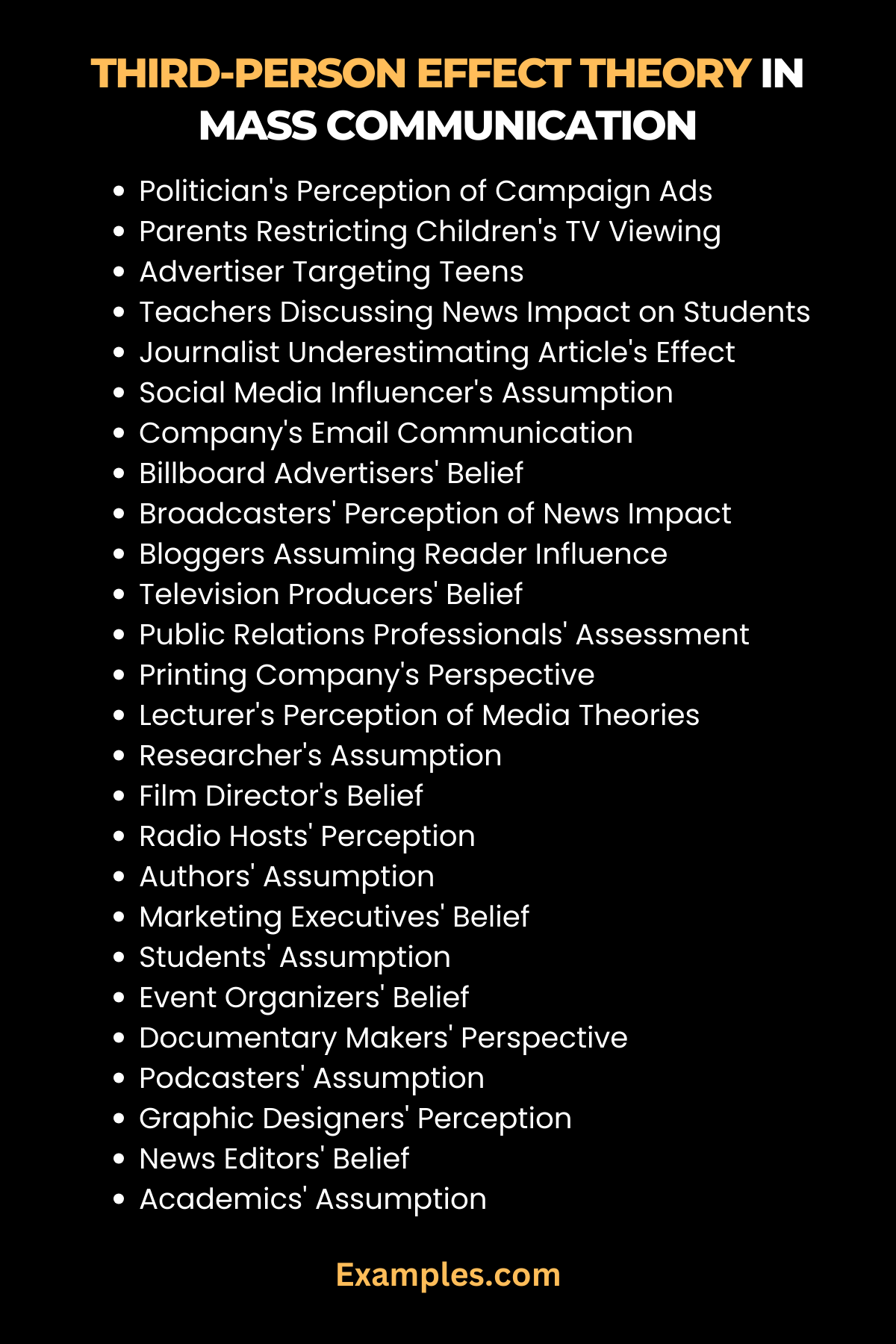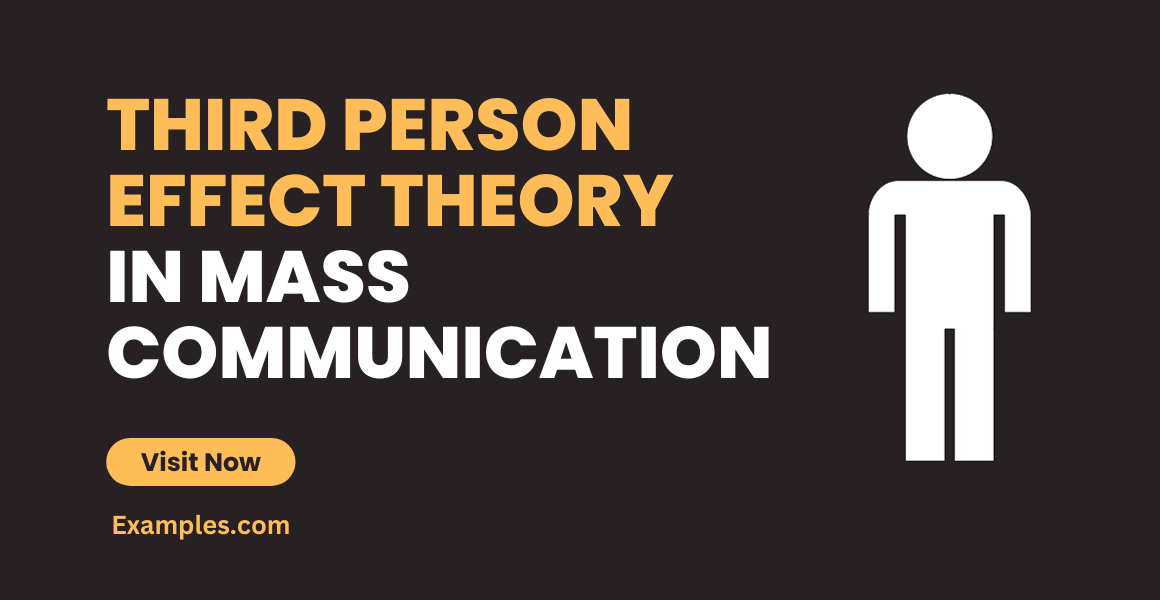29+ Third-Person Effect Theory in Mass Communication Examples
The Third-Person Effect Theory in Mass Communication offers a fascinating exploration into how media messages are perceived differently by individuals. This theory, integral to understanding Mass Communication in Real Life, delves into the psychological effects of media on audiences. It’s crucial in fields like Public Relations Mass Communication, where anticipating audience reaction is key. This guide, enriched with practical examples, demonstrates the theory’s significance in everyday media interactions, making it an essential resource for students and professionals alike.
What is Third-Person Effect Theory in Mass Communication?
The Third-Person Effect Theory in Mass Communication postulates that individuals tend to believe that others are more influenced by media messages than they are themselves. This simple yet profound concept helps explain various phenomena in mass communication, from advertising effectiveness to social media dynamics.

History
The Third-Person Effect Theory in Mass Communication has been a significant concept since its inception. This theory, which emerged in the late 20th century, postulates that individuals tend to believe that mass media messages have a greater effect on others than on themselves. This perception often leads to a variety of reactions, ranging from self-censorship to advocacy for public policy changes.
Origin and Development
The theory was first introduced by W. Phillips Davison in 1983. Davison observed that people often overestimate the impact of persuasive communications on others while underestimating their effect on themselves. This phenomenon was noted across various forms of mass personal communication, including television, radio, and newspapers.
Impact on Mass Communication Characteristics
Understanding the Third-Person Effect is crucial in comprehending the broader mass communication characteristics. It sheds light on how audiences interact with media messages and the resultant social behaviors. For instance, in advertising and political campaigns, the assumption that messages will have a stronger effect on others can influence how these messages are crafted and targeted.
Influence on Media and Policy
The theory has significant implications for media regulation and public policy. Concerns about the potential harmful effects of media on the public have led to stricter content regulations. This is evident in various areas of mass communication, such as broadcasting and social media.
Applications in Modern Media
In the digital age, the Third-Person Effect Theory finds relevance in online environments as well. The rise of social media and blogging has transformed how information is disseminated and consumed. Here, the perception of media influence extends to how individuals perceive the impact of online content on others, influencing their own sharing and consumption behaviors.
What is the Best Example of Third-Person Effect Theory in Mass Communication?
A classic example of the Third-Person Effect Theory in Mass Communication is observed in advertising campaigns. People often assume that others are more susceptible to persuasive ads, leading them to underestimate the ads’ influence on their own behavior and attitudes. Another instance is seen in news consumption, where individuals might believe that others are more affected by media bias or sensationalism than they are, potentially shaping their perceptions and discussions about current events. This theory highlights the nuanced ways in which media messages are interpreted and internalized differently by each individual.

30 Examples of Third-Person Effect Theory in Mass Communication
Third-Person Effect Theory in Mass Communication: This theory explores how people often believe others are more influenced by mass media than themselves, impacting societal behavior and perspectives. This description is rich in Mass Communication Characteristics and Types of Mass Communication, emphasizing its significance in media studies and practical application in various communication fields.

- A politician believes campaign ads affect voters more than himself: Demonstrates the third-person effect in political campaigning.
- Parents restrict children’s TV viewing, thinking they’re more susceptible: Reflects the theory in a family Mass Communication Scenario/Situation.
- An advertiser targets teens, assuming they are more influenced by ads: Shows the application in Mass Communication in Advertising.
- Teachers discussing how news impacts students’ opinions more than their own: An example in an educational Mass Communication Examples in School setting.

- A journalist underestimating the effect of her article on her beliefs: Highlights the theory in Journalism Mass Communication.
- Social media influencers assume followers are more swayed by posts: Illustrates the theory in Social media Mass Communication.
- A company sends emails, thinking clients are more persuaded than the team: A Mass Communication Examples in Real Life scenario, using Email Mass Communication.
- Billboard advertisers believe the public is more influenced than themselves: A practical application in Billboard Mass Communication.
- Broadcasters think their news impacts the audience’s views more than theirs: Shows the theory in Broadcasting Mass Communication.
- Bloggers assuming readers are more affected by content than themselves: A common misconception in Blog Mass Communication.
- Television producers think shows shape viewers’ ideas more than their own: An example of Television Mass Communication influence.
- Public relations professionals overestimate the effect of press releases on the public: Demonstrates the theory in Public Relations Mass Communication.
- Printing companies believe flyers affect customer opinions more than theirs: Highlights Printing Mass Communication impact.
- A lecturer thinks students are more influenced by media theories than he is: An educational example of Mass Communication Theories.
- A researcher assumes the public is more swayed by health campaigns than herself: Reflects Mass Communication in Real Life.
- Film directors believe movies shape audience beliefs more than their own: A scenario in Mass Personal Communication.
- Radio hosts think listeners are more affected by broadcasts than themselves: An instance of Mass Communication in Broadcasting.
- Authors assume readers are more influenced by books than they are: Shows the third-person effect in Mass Communication Thesis Examples.
- Marketing executives believe consumers are more swayed by ads than they are: A Mass Communication Examples in a Digital Age scenario.
- Students think classmates are more influenced by online courses than themselves: Reflects the theory in Mass Communication Jobs/Careers.
- Event organizers believe attendees are more affected by promotions than themselves: An example of Mass Communication in Real Life.
- Documentary makers think viewers are more swayed by their films than they are: A case in Mass Communication Examples in Journalism.
- Podcasters assume the audience is more influenced by episodes than themselves: Demonstrates the theory in Mass Communication Dissertation.
- Graphic designers think clients are more affected by visuals than they are: Highlights Mass Communication Messages.
- News editors believe readers are more swayed by articles than they are: An example of Gatekeeping Theory in action.
- Academics think the public is more influenced by their research than themselves: Shows the third-person effect in Mass Communication Thesis Ideas.
- Retailers assume shoppers are more affected by store announcements than they are: A Mass Communication in Retail scenario.
- HR managers think employees are more influenced by internal communications than they are: Reflects Internal Mass Communication.
- Health campaigners believe the public is more swayed by their messages than they are: An application of Mass Communication in Public Health.

- CEOs think employees are more affected by corporate news than they are: Illustrates the theory in Mass Communication in Corporate Settings.
Role of Third-Person Effect Theory in Mass Communication
The Third-Person Effect Theory plays a crucial role in understanding the dynamics of Mass Communication. This theory posits that individuals tend to believe that others are more influenced by mass media messages than they are themselves. Here’s how it impacts mass communication:
- Perception of Influence: In mass communication, this theory suggests that people may perceive media messages as having a greater effect on others than on themselves. This perception can significantly shape public opinion and behavior.
- Media Content and Public Reaction: The theory is essential in predicting how different groups within society will react to specific media content. Understanding this helps in tailoring messages that are more effective and less likely to be dismissed.
- Regulation and Censorship: It influences decisions regarding media regulation and censorship, as policymakers may assume a greater effect of media on the public, leading to stricter controls.
Importance of Third-Person Effect Theory in Mass Communication
Understanding the Third-Person Effect Theory is vital for several reasons:
- Effective Communication Strategies: It aids in developing strategies that minimize negative perceptions and enhance positive communication outcomes in mass media.
- Target Audience Analysis: This theory helps in analyzing how different audience segments might perceive and be influenced by media messages. Such analysis is crucial for effective Mass Communication Characteristics.
- Public Policy Implications: The theory has significant implications for public policy, particularly in areas like advertising and political campaigning, where understanding audience perception is key.
How to use Third-Person Effect Theory in Mass Communication
Applying the Third-Person Effect Theory in mass communication involves several strategic steps:
- Audience Segmentation: Identify different segments of your audience and understand how they might perceive the media’s influence on themselves versus others.
- Message Framing: Frame your messages in a way that acknowledges the perceived greater influence on others. This can be particularly effective in persuasive communication.
- Feedback Mechanisms: Incorporate feedback mechanisms to understand and address the audience’s perceptions and reactions to media messages.
- Policy Formulation: Utilize the theory in formulating media-related policies and regulations, ensuring they are based on realistic perceptions of media influence.
- Ethical Considerations: Apply the theory ethically, understanding its implications on public opinion and behavior, to avoid manipulative practices.
Understanding the Third-Person Effect Theory in mass communication is crucial for professionals in the field. This theory highlights the unique Mass Communication Characteristics and scenarios, offering valuable insights for educators, journalists, and PR specialists. By grasping these concepts, one can effectively navigate the complex landscape of media influence and communication strategies.



